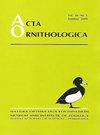Nest Orientation in Closed Nests of Passeriformes across a Latitudinal Gradient in the Southern Neotropic
IF 1.3
4区 生物学
Q3 ORNITHOLOGY
引用次数: 4
Abstract
Abstract. Birds are expected to orient their nests non-randomly in order to avoid extreme thermal conditions that are known to affect their reproductive success. Considering the hypotheses that yearly mean temperature influences entrance orientation in birds, nests at higher latitudes are expected to face the equator in order to take advantage of warmer temperatures. Here we explore the relationship between latitude and nest entrance orientation in closed nests of Passeriformes in the southern Neotropics (Furnariidae, Rhinocryptidae, Troglodytidae, Tyrannidae), using both published and original data. We found a positive and significant correlation between mean entrance orientation and latitude, and report significantly non-random nest orientation at 62% of the locations with available samples. Overall, there is a trend for nests at lower latitudes to have north-northeasterly orientations, and for nests at higher latitudes to be oriented northwest. The reasons for the observed trends remain unclear, but likely involve the availability and intensity of solar radiation and its effect upon the nest microclimate.新热带南部一个纬度梯度上雀形目闭巢的巢方位
摘要为了避免极端的温度条件,鸟类被认为会影响它们的繁殖成功,它们的巢是非随机的。考虑到年平均温度影响鸟类入口方向的假设,高纬度地区的鸟巢应该面向赤道,以便利用更温暖的温度。本文利用已发表的资料和原始资料,探讨了新热带南部雀形目(狐螨科、鼻隐螨科、穴居螨科、暴龙螨科)封闭巢中纬度与巢入口方向的关系。我们发现平均入口方向与纬度之间存在显著的正相关关系,并且在62%的可用样本中报告了显著的非随机巢方向。总体而言,低纬度地区的巢有东北偏北朝向的趋势,高纬度地区的巢有西北朝向的趋势。观测到的趋势的原因尚不清楚,但可能与太阳辐射的可用性和强度及其对巢小气候的影响有关。
本文章由计算机程序翻译,如有差异,请以英文原文为准。
求助全文
约1分钟内获得全文
求助全文
来源期刊

Acta Ornithologica
生物-鸟类学
CiteScore
2.10
自引率
0.00%
发文量
14
审稿时长
>12 weeks
期刊介绍:
Publishes scientific papers (original research reports, reviews, short notes, etc.) and announcements from all fields of ornithology. All manuscripts are peer-reviewed.
Established in 1933 as Acta Ornithologica Musei Zoologici Polonici, since 1953 continued under the present title.
Published twice a year by the Natura Optima Dux Foundation under the auspices of the Museum and Institute of Zoology, Polish Academy of Sciences.
 求助内容:
求助内容: 应助结果提醒方式:
应助结果提醒方式:


